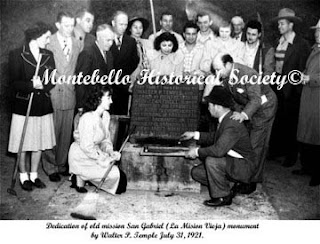Today is
Dia de los Muertos, or Day of The Dead. No, not the
Grateful Dead, but it
is a day where people show their gratefulness for their deceased loved ones. And though it's a holiday practiced by the Mexican community, here in multicultural Los Angeles, it's starting to grow into
more than just a Mexican thang.
Last year,
The Militant paid homage to some great Angelenos by visiting their gravesites at Culver city's Holy Cross Cemetery. Earlier this week, The Militant paid a visit to
Inglewood Park Cemetery, just a few miles south.
At a sprawling 340 acres nestled between
Centinela Park in the north and
The (formerly Fabulous) Forum to the south, Inglewood Park Cemetery was founded back in 1905 by a group of businessmen who saw the need for memorial park space in the the Centinela Valley area (The City of Inglewood wasn't incorporated until three years later). The first people laid to rest there were the original settlers of that area and other places in the South Bay. There was once a Los Angeles Railway Yellow Car line along Florence Avenue (now part of the proposed
Metro Crenshaw/LAX Light Rail Line) which ran special funeral cars to the cemetery.
Inglewood Park also boasts having the most interments of any cemetery in Southern California, so it's quite a significant and historic resting place for many in the Southland.
A number of Los Angeles mayors have their final resting place here, beginning with John Bryson, who held a short mayoral term in 1888-1889. The controversial
Frank L. Shaw, who was elected in 1933 and was the first American city mayor ever recalled from office five years later (due to police misconduct and corrupt mishandling of city funds), is buried here, as is his popular reformist successor,
Fletcher Bowron, mayor from 1938 to 1953.
But the most recent, and most famous Los Angeles mayor, interred here is
Tom Bradley, mayor from 1973 to 1993, the City's first African American mayor and the civic leader who gave us a skyline, a subway, an Olympics and the internationally diverse metropolis we know today.

Other elected officials resting here are U.S. Congressman
Julian Dixon, whose efforts to federally-fund our Metro Rail system got his name immortalized at the 7th Street/Metro Center station. Also, County Supervisor and local political patriarch
Kenneth Hahn (whose name is also immortalized in a Metro Station, for creating the Blue Line) is buried here.
Several figures in the music world are buried here at Inglewood Park, most notably
Ray Charles, who is buried in the large Mausoleum of the Golden West (under his full name, Ray Charles Robinson). Unlike Mayor Bradley, who rests just a few feet from the entrance of his mausoleum, the legendary blues and soul singer (and former Baldwin Hills resident) is interred deep within several halls from the entrance. Yes, the Militant walked through dimly-lit mausoleum corridors -- alone -- just to bring you a picture of his resting place (note the music treble clef in his name plate and the coins resting at the base).
Songstress
Ella Fitzgerald is another music legend laid to rest here, but The Militant was unable to locate her tomb.
There's another person from the entertainment world buried here, but you'd never know by looking at his name.

The name "
William B. Thomas"
may or may not be familiar to you, but his most famous character would make it all clear. For he was "
Buckwheat," the character that Thomas, a native Angeleno, played for several years as a child actor in Hal Roach's
Our Gang (a.k.a.
The Little Rascals) film shorts from the 1930s-1940s
. The most well-known of the black characters on that show, the racial integration - and equal treatment - of the cast back then was groundbreaking. Roach was inspired to create
Our Gang after seeing an integrated group of kids play together in the Echo Park area. Only in Los Angeles! Although, Thomas' WWII credentials on his epitaph are inaccurate: Though he did serve in the U.S. Army, he was only 14 when World War II ended. He did serve during the Korean War era though.
Lastly, The Militant brings you two famous Angeleno attorneys who are eternally tied together in many ways at Inglewood Park:

Lawyer
Johnnie Cochran, most famous for being the lead attorney in the O.J. Simpson murder trial, and has represented everyone from former Black Panther Elmer "Geronimo" Pratt to 1992 Riots beating victim Reginald Denny, rests in the Manchester Garden Mausoleum in the southern side of the cemetery. And on the eastern side of the park forever rests his "Dream Team" defense partner...
, a native Angeleno attorney, businessman and patriarch of...well...
you know.
Speaking of which, unlike the tombs of the former mayor, the famous architect, the legendary musician and his Simpson trial partner...there are no flowers on his grave. Gee, with all those rich and famous kids of his, you'd
think they'd even bother to remember their dad? You know, the guy who provided them with their wealthy lifestyle and the family name they wear like a brand? America tries to keep up with The Kardashians, but The Kardashians apparently don't bother to keep up with remembering their own father.
But this mysterious, anonymous Angeleno blogger did, as with the other legendary Angelenos who are laid to rest here at Inglewood Park Cemetery. So take a moment today to honor, in whatever way you wish, the Angelenos, whether rich or poor, famous or personally known, who have contributed in any way to your life in this city and love for this city and are no longer with us. Have a great Dia de los Muertos, y'allz.






















